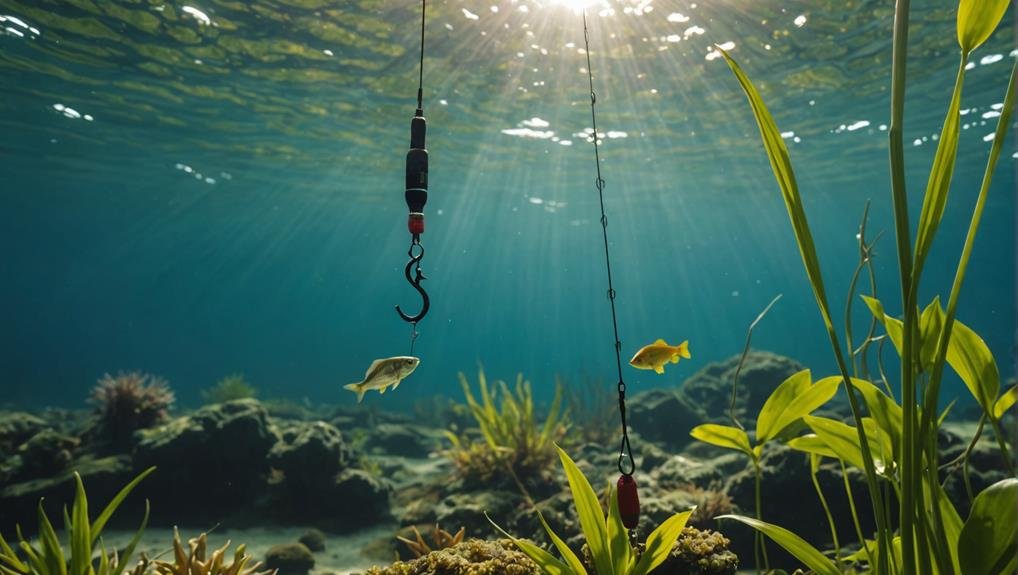You’re probably familiar with various fishing techniques, but have you ever considered the drop shot rig? With a hook positioned above a weight, this setup lets your bait hover enticingly off the bottom, making it perfect for demanding or suspending fish. You’ll need a medium-light spinning rod, fluorocarbon line, and some finesse to tie the Palomar knot correctly. But what sets this rig apart? It’s the fine-tuned control you have over your bait’s presentation. Let’s explore how to tailor this technique to suit different fishing conditions and see why it’s so effective.
Key Takeaways
- The drop shot rig features a hook above the weight, allowing the bait to hover off the bottom.
- It is highly effective for catching finicky or suspending fish due to precise bait placement.
- Use a medium-light spinning rod, fluorocarbon line, and a size 1 to 1/0 hook with soft plastic or live bait.
- Experiment with different leader lengths and weights to target fish accurately in various water depths.
- Employ the Palomar Knot to securely attach the hook, ensuring optimal bait presentation and movement.
What Is a Drop Shot Rig
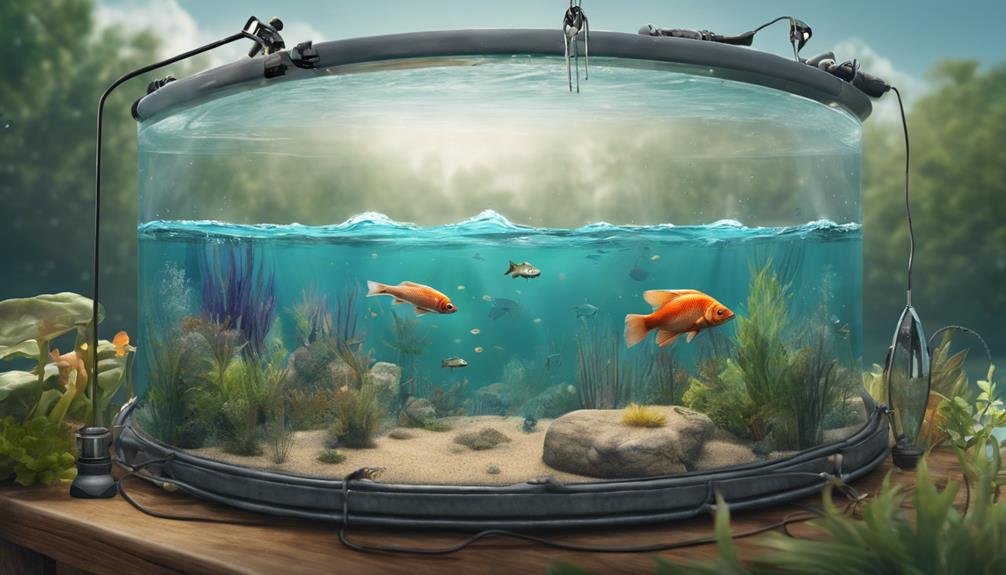
In its simplest form, a drop shot rig is a finesse fishing setup where the hook is tied above a weight, allowing the bait to hover just off the bottom. This technique particularly targets finicky or suspending fish, especially in clear or deep water conditions. A drop shot rig can achieve precise bait placement, which is important when dealing with cautious or picky fish like bass.
The beauty of this finesse technique lies in its versatility and adaptability. You can easily adjust the leader length and the weight size to customize your presentation, targeting different depths with pinpoint accuracy. This makes it an excellent choice for bass fishing and other species, such as bluegill, crappie, and walleye.
When you cast your line with a drop shot rig, the weight guarantees the bait remains suspended above the bottom, creating a natural, enticing presentation that’s hard for fish to resist.
This setup allows you to keep the bait in the strike zone longer, increasing your chances of a successful catch.
Basic Setup and Gear
When setting up a drop shot rig, select a medium-light spinning rod paired with a fluorocarbon line. This setup is ideal for clear or deep water, where the drop shot rig truly excels at targeting wary fish. The fluorocarbon line is nearly invisible underwater, enhancing your chances of a successful catch.
You’ll need a small, sharp hook and a cylindrical weight for the rig. The hook is tied above the weight, letting your bait float enticingly off the bottom. This setup mimics natural prey behavior, making it irresistible to fish.
Here’s a quick reference to help you set up your gear:
| Component | Recommendation |
|---|---|
| Spinning Rod | Medium-light |
| Line | Fluorocarbon |
| Weight | 1/8 to 1/4 ounce |
| Hook | Size 1 to 1/0 |
| Bait | Soft plastic or live |
Braided lines can also be beneficial, especially for enhancing sensitivity and improving hhookupratios. Fluorocarbon is great for its invisibility, braided strength, and feedback, letting you feel even the slightest nibble.
With different weights and hook sizes, you can tailor your presentation to target various fish species. This flexibility makes the drop shot rig versatile in your fishing arsenal.
Knot Tying Instructions

Let’s prepare your drop shot rig by mastering the Palomar Knot.
Start by doubling 12 to 30 inches of line and passing the loop through the eye of the hook.
Then, tie a loose overhand knot with the hook hanging from the bottom.
Palomar Knot Steps
Double your fishing line to create a loop to tie a Palomar knot. Pass this loop through the eye of your drop shot hook. Now, tie an overhand knot with the loop and the main line, ensuring the hook dangles loosely. Be cautious not to twist the lines as you tie the overhand knot.
Next, take the loop and pass it over the hook. This guarantees that the hook is securely captured within the knot.
Once you’ve done this, you’ll need to pull on both the main line and the tag end of the line to tighten the knot. As you pull, make sure the knot cinches down smoothly and evenly. You might need to moisten the line slightly to ensure it tightens without friction, preserving its strength.
Leader Length Considerations
Choosing the right leader length for your drop shot rig is significant for optimizing your fishing success. The size of your leader can impact how freely your bait moves and how sensitive your rig is to fish behavior. Typically, a leader’s length ranges from 12 to 30 inches, and the choice depends on various factors like water clarity, bottom structure, and how active the fish are.
Shorter leaders, around 12-18 inches, are common for finesse presentations. They allow greater sensitivity and control over your bait’s movement, which is pivotal in clear water or targeting finicky fish. On the other hand, longer leaders up to 30 inches are ideal for deeper waters or when fish are less active, as they provide more natural bait movement.
Experimenting with different leader lengths can help you find the most effective setup for your conditions. Here’s a quick reference table to help you decide:
| Leader Length | Ideal Conditions | Benefits |
|---|---|---|
| 12-18 inches | Finesse presentations | Increased sensitivity and control |
| 18-24 inches | Moderate conditions | Balance of movement and control |
| 24-30 inches | DeDeepwaterinactive fish | Maximum bait movement |
Adjust your leader length based on water clarity and fish behavior to maximize your drop shot rig’s effectiveness.
Hook Attachment Tips
When setting up your drop shot rig, fastening the hook properly is necessary for a successful fishing experience. One of the best methods for hook attachment is using the Palomar knot. This knot is known for its reliability and strength, making it ideal for drop-shot rigging. Here’s how you can tie it:
First, double about six inches of your fishing line and pass the loop through the eye of the hook. Next, tie a simple overhand knot with the doubled line, making sure the hook hangs freely. Pull the loop end over the hook, then slide it above the eye. Finally, moisten the knot and pull both ends of the line to tighten it securely.
Mastering the Palomar knot is important because it guarantees that your hook attachment is secure and won’t slip or come loose. This knot also enhances the sensitivity of your setup, allowing you to detect even the slightest nibble.
Properly tying the Palomar knot means your bait will be presented correctly, increasing your chances of a successful catch. Practice this knot, and you’ll be well on mastering drop-shot rigging.
Effective Fishing Techniques
To maximize your success with a drop shot rig, perfect your bait presentation and accurately adjust your depth to target fish.
Experiment with varying leader lengths and weights to create natural bait movements that attract wary fish.
Adjust your setup based on water clarity and depth to adapt to changing conditions and maximize your catch.
Bait Presentation Tips
Effective bait presentation can make all the difference in your success with a drop shot rig. To maximize your chances, experiment with soft plastic baits of soft plastic baits of different sizes and colors to match the water conditions and fish preferences. A slow retrieve addition can mimic natural prey and entice fish to strike.
Always cast near structures like rocks, ledges, and vegetation where fish are likely hiding. These spots offer fish shelter and food, making them prime locations for your drop shot rig.
Vary your retrieval speed and technique to see what triggers more strikes. Sometimes a faster retrieve might work, while other times a slower, more deliberate approach might be needed.
Enhancing your bait with scent attractants can also make a big difference. Applying these to your soft plastic baits can increase fish interest and bite rates. Fish rely heavily on their sense of smell; scented bait can be the extra edge you need.
Depth Adjustment Strategies
Adjusting the depth of your drop shot rig is crucial in hitting those sweet spots where fish are lurking. To start, you’ll want to vary the leader length.
A longer leader lets your bait hover higher in the water column, which is important for targeting suspended fish. Conversely, a shorter leader gets your bait closer to the bottom, ideal for bottom-dwelling species.
Experimenting with different weight sizes is also vital.
Heavier weights sink faster, which is beneficial in deeper water or when you need to maintain a specific sink rate. Lighter weights are perfect for shallow waters, slowing the descent and giving you more control.
Use your fishing rod tip to feel when the weight hits the bottom. This tactile feedback helps you gauge the depth and make necessary depth adjustments.
Don’t forget to consider external factors like water temperature, time of day, and fish behavior. Fish often move to different depths depending on these variables.
Electronics such as fish finders or depth sounders can be invaluable for pinpointing target fish and adjusting your rig depth precisely. Remember, the more you fine-tune your depth adjustments, the better your chances of landing that perfect catch.
Recommended Equipment
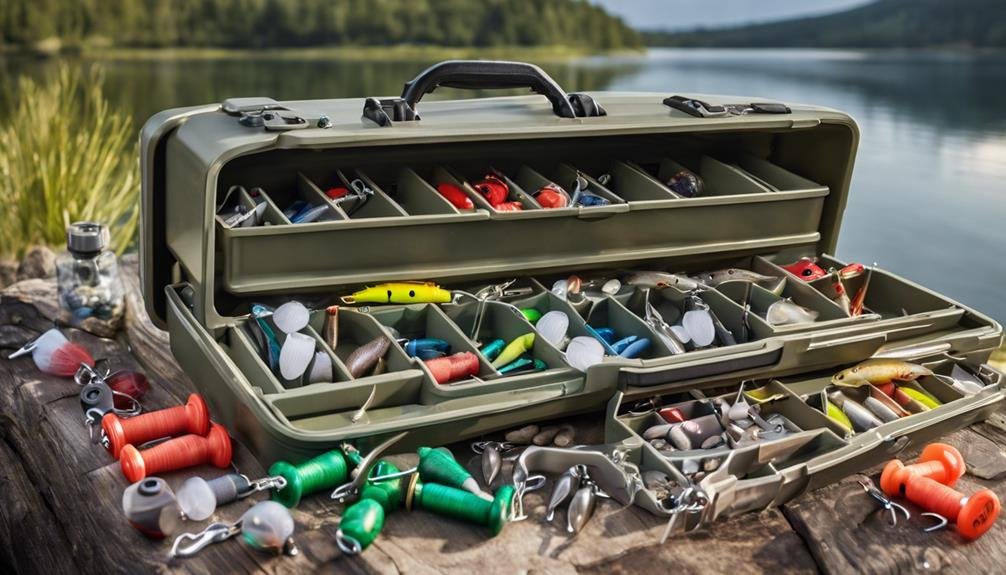
When gearing up for drop shot fishing, your best bet is a 7-foot medium-light spinning rod paired with a 6-8-pound fluorocarbon line. This setup provides the sensitivity and control to detect subtle bites and effectively work your drop shot rig. Opt for the braided line to add extra sensitivity and improve your hhookupratio, especially when using finesse gear.
To maximize your success, here is a quick hookup checklist of essential gear:
- Lightweight Rod: A 7-foot medium-light spinning rod offers the perfect balance of sensitivity and strength.
- Fishing Line: Use a 6-8 pound fluorocarbon line for invisibility underwater and better bait presentation.
- Drop Shot Hook: Choose No. 1-1/0 size hooks with thin wire to enhance your landing percentages.
- Dropshot Weight: Vary the weights and leader lengths to match different water conditions and bait movements.
Additionally, selecting the right drop shot baits is vital. For the best results, use finesse baits in green hues like Green Pumpkin and Watermelon Red. These colors mimic natural prey and can entice more bites. Remember, the key to a successful drop shot rig is having the right gear and knowing how to use it effectively.
Specialized Techniques
Small live nightcrawlers on a small hook can be incredibly effective when targeting bluegill with a finesse setup, especially during spring.
For shoreline bass, focus on break lines and use small twitches during your retrieve to attract bites.
These specialized techniques can help you catch various species throughout different seasons.
Bluegill Finesse Setup
Targeting bluegill with a finesse setup using a drop shot rig demands precision and subtlety. Drop shot fishing is particularly effective for bluegill because it allows you to present small baits with great control. Light tackle, such as an ultralight rod and reel, paired with small live nightcrawlers on a tiny hook, can make a big difference, especially when targeting bluegill beds in the spring.
Here are four tips to help you master this technique:
- Choose the Right Gear: Use an ultralight setup to feel even the slightest nibbles. Light line, around 2-4 lb test, is ideal.
- Bait Selection: Small baits like nightcrawlers or tiny artificial worms work wonders. Bluegill have small mouths, so keep your bait size minimal.
- Targeting Locations: Focus on bluegill beds, typically found in shallow waters during spring. Drop shot fishing from shore can be highly effective along break lines.
- Subtle Movements: Bluegill responds well to finesse techniques. Use gentle twitches and slight lifts to make your bait dance just off the bottom, enticing bites.
Adapt your drop shot rig to fish just off the bottom in various seasons, making this approach versatile and successful for bluegill.
Shoreline Bass Targeting
You’ll need to focus on specific areas like break lines, structure, and cover to effectively target bass from the shoreline using a drop shot rig. These spots are prime locations where bass often hide and ambush prey. When casting from the shore, aim for these key areas to maximize your chances of enticing a bite.
While retrieving, use small twitches and subtle movements to mimic the natural behavior of prey. This technique can be particularly effective in shallow waters where bass can be more cautious. The drop shot rig’s finesse presentation is ideal for these scenarios, allowing you to make your lure appear lifelike and irresistible to bass.
Adjusting the depth of your drop shot rig is essential. Pay attention to fish behavior and water conditions to determine the best depth for your setup. Sometimes, bass might be closer to the bottom, while others could be suspended mid-depth.
Experiment with different baits, such as worms, minnows, or soft plastics, to see how the bass responds. Staying observant and adaptable is key. By closely monitoring bass behavior and tweaking your techniques, you’ll enhance your shoreline bass targeting success with the drop shot rig.
Expert Insights
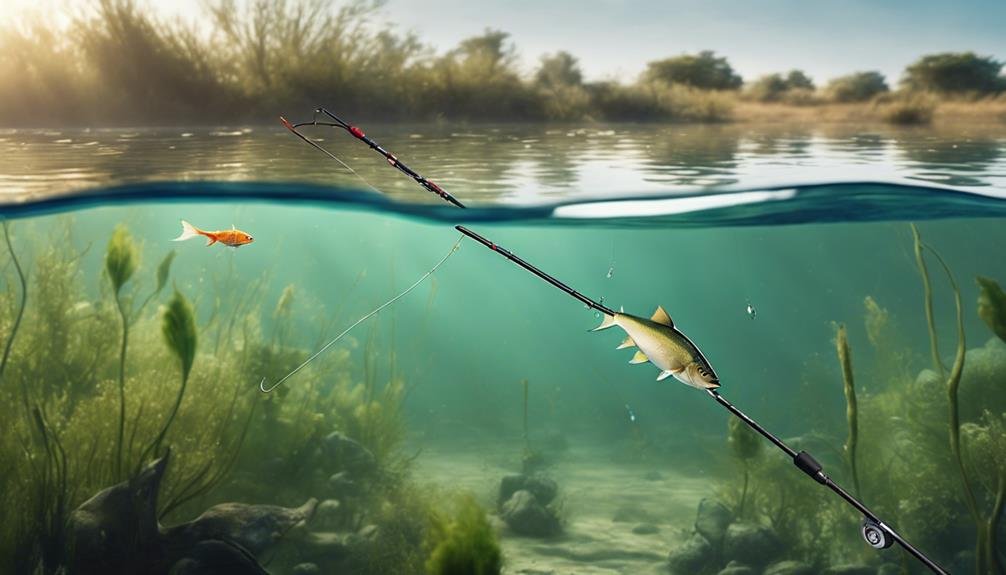
Expert anglers like Aaron Martens and Walker-Smith have revolutionized drop shot fishing, transforming it into an important technique for bass anglers. Their expert insights have made it easier to master this finesse technique, especially in challenging and clear-water situations.
A drop shot rig is incredibly versatile, enabling you to precisely target largemouth, smallmouth, spotted bass, and even bluegill.
To enhance your drop shot fishing skills, consider these expert tips:
- Master the Palomar Knot: Tying a Palomar knot is essential for effectively securing your hook to the line. This knot provides strength and guarantees your bait is presented correctly.
- Focus on Finesse: Drop-shot fishing is all about subtlety. Use light lines and smaller baits to entice cautious fish, especially in clear or deep water.
- Stay Versatile: Adapt your drop shot rig to different conditions. Experiment with various leader lengths and weights to find what works best for your target fish.
- Learn From the Pros: Study the techniques and tactics of experts like Martens and Smith. Their experience can guide you in refining your approach and improving your catch rate.
Choosing Weights and Hooks
Building on the expert insights from Martens and Smith, let’s focus on the essential components of your drop shot rig, starting with weights and hooks. Using the right weights and hooks can significantly impact your fishing success. Tungsten drop shot weights are a top choice because they offer enhanced sensitivity and are environmentally friendly alternatives to lead. This lets you feel every bump and contour underwater.
There are various types of weights to contemplate. Skinny drop shot weights have a streamlined profile that reduces snags and improves your perception of the bottom structure. Round or ball-shaped weights come with a chip-proof coating and a line-swivel design, ensuring better bait presentation. Quickshot drop shot wires offer easy weight conversion and versatility, letting you adjust your rig setup quickly.
Here’s a handy table to help you compare:
| Weight Type | Features | Benefits |
|---|---|---|
| Tungsten | High sensitivity, eco-friendly | Better feel, environmentally safe |
| Skinny | Streamlined profile, reduced snags | Improved bottom feel, fewer snags |
| Round/Ball | Chip-proof coating, line-swivel design | Enhanced presentation, durable |
| Quickshot | Easy conversion, versatile setup | Quick adjustments, flexibility |
Selecting the right hooks is equally essential. Ensure they are sharp and appropriately sized for your target fish species. By choosing the right weights and hooks, you can enhance the effectiveness of your drop shot rig.
Bait Selection and Presentation
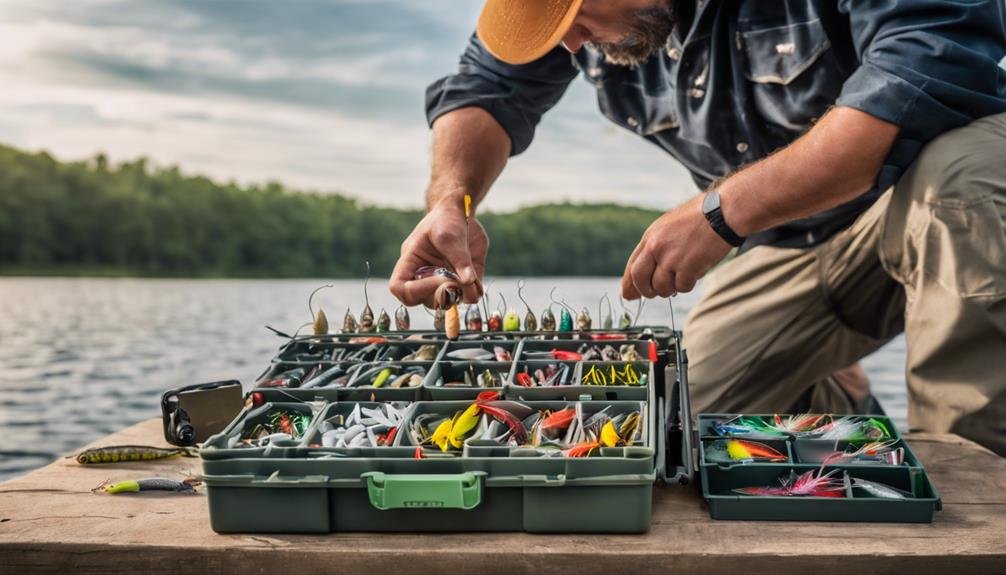
Selecting the right bait for your drop shot rig can greatly influence your fishing success. Soft plastic baits are the go-to choice for their lifelike appearance and versatility. To make the best of your drop shot rig, consider these key factors:
- Bait Colors: Match the bait colors to the water conditions and fish preferences. Clear water calls for natural, subtle hues, while murky water benefits from brighter, more visible colors.
- Bait Sizes: Experiment with different bait sizes to find the ideal size for your target fish species. Smaller baits can attract more bites, while larger ones may entice bigger fish.
- Scent Attractants: Adding scent attractants to your soft plastic bait can enhance its appeal. Scents mimic natural prey and can trigger more strikes, especially in challenging conditions.
- Natural Prey Movement: Mimic the movement of natural prey by using a slow, twitching retrieve. This technique can make your bait appear more lifelike and irresistible to fish.
Don’t forget to cast near structures where fish might be hiding. Using the right combination of bait color, size, scent, and movement will significantly increase your chances of success with a drop shot rig.
Common Challenges and Tips
Anglers often face a few common challenges when using a drop shot rig that can impact their fishing success. One major issue is tackling tangles. Keeping the line short between the hook and the main line helps prevent this issue. When tying the hook, ensure it’s secure but not so tight that it limits movement, as this can hinder bait presentation.
Another challenge is potential snags at the bottom. To reduce snags, use long, slender, cylindrically shaped drop-shot weights. These weights slide through rocks and vegetation more easily, minimizing the chance of getting stuck. The end of your rig should have a properly secured drop-shot weight to maintain balance and effectiveness.
Rig complexity can also be overwhelming. Simplify your setup using a traditional drop shot rig; it’s often more effective than modified versions. Having a swivel at the top of your rig can prevent line twists and maintain the integrity of your setup.
Conclusion
Mastering the drop shot rig can seriously up your fishing game. By fine-tuning your gear, perfecting the Palomar knot, and experimenting with different weights and leader lengths, you’ll be ready to tackle even the most finicky fish. Don’t forget to choose the right bait and practice your presentation techniques. With these tips and some patience, you’re on your way to becoming a drop-shot pro and enjoying more successful fishing trips.
FAQs
What is a drop shot rig?
A drop shot rig is a popular finesse fishing setup for targeting species like bass. It consists of a hook tied to the main fishing line, with the bait positioned above a weight on the bottom. This rig allows the bait to hover off the ground, mimicking small prey and attracting fish. It is especially effective for fishing in deep water, rocky areas, or when the fish are less active and require a subtle presentation.
Key Features:
- Weight on Bottom: Keeps the rig grounded while the bait floats above.
- Suspended Bait: Bait is presented off the bottom, making it highly visible to fish.
- Finesse Technique: Ideal for fishing in difficult or pressured waters.
How do you set up a drop shot rig?
Setting up a drop shot rig is simple, and it requires minimal gear. Follow these steps to get started:
- Tie the Hook: Start by tying your hook onto the main fishing line using a Palomar knot. When tying, leave a long tag end (around 12-24 inches) for attaching the weight.
- Position the Hook: After tying the hook, ensure the hook point faces upward to ensure proper bait presentation.
- Attach the Weight: Attach a drop shot weight toAttach a drop shot weight to the tag end of the line (left after tying the hook). Depending on the water depth and fish behavior, then fish behavior, the weight should be positioned 12-18 inches below the hook.
- Rig the Bait: Hook a soft plastic bait (like a worm, minnow, or shad) onto the drop shot hook. Depending on the bait and fishing conditions, you can rig it nose-hooked or in a wacky style.
Setup Steps:
- Palomar Knot: Tie the hook with the knot, leaving a long tag end.
- Position Hook: Ensure the hook points upwards.
- Attach Weight: Place the weight 12-18 inches below the hook.
- Rig Bait: Hook soft plastic bait for realistic movement.
When should I use a drop shot rig?
The drop shot rig is ideal for finesse fishing and is particularly effective when bass are in deeper waters, less active, or under high fishing pressure. Here are some perfect conditions for using a drop shot rig:
- DeDeepwaterishing: The rig lets you present the bait just above the bottom in deep waters, where bass often feed.
- Clear Water: In clear waters, fish are more cautious, and the subtle presentation of the drop shot rig can entice bites when other techniques fail.
- Rocky or Vegetated Areas: The drop shot rig can be fished effectively in rocky or grassy areas where you want to keep the bait just above obstructions.
Best Use Cases:
- Deep Water: Perfect for fishing in deeper parts of lakes or rivers.
- Clear Water: Subtle presentation works well in clear water environments.
- Rocky/Grassy Areas: Keeps bait suspended above obstacles like rocks or weeds.
What are the best baits for a drop shot rig?
The drop shot rig works well with a variety of soft plastic baits. Some of the most effective options include:
- Soft Plastic Worms: The most common choice is worms like the Roboworm or Zoom Trick Worm, which mimic natural prey and provide subtle action that attracts bass.
- Minnow or Shad Imitations: Soft plastics that imitate baitfish, such as the Zoom Fluke or Berkley PowerBait Minnow, are ideal for targeting bass feeding on smaller fish.
- Creature Baits: Small creature baits like the Zoom Brush Hog can be effective in rocky areas where bass are foraging for crayfish.
Best Baits:
- Soft Plastic Worms: Roboworm or Zoom Trick Worm.
- Minnow/Shad Imitations: Zoom Fluke or Berkley PowerBait Minnow.
- Creature Baits Small Brush Hogs for crayfish imitation.
How do you fish with a drop shot rig?
Fishing with a drop shot rig requires a finesse approach, focusing on subtle movements to entice bites. Here’s how to fish the rig effectively:
- Cast and Let the Rig Sink: Cast the rig and allow the weight to reach the bottom. Keep the line slightly slack as it sinks.
- Twitch and Jiggle the Bait: Once the rig is on the bottom, gently twitch or jiggle the bait by lifting and lowering the rod tip. This movement makes the bait appear alive and attracts fish.
- Maintain Bottom Contact: Keep the weight in contact with the bottom as you work the bait slowly. Reel in any slack and gently shake the rod to keep the bait moving.
- Set the Hook: Avoid aggressively jerking the rod when you feel a bite. Instead, reel in the slack and set the hook with a firm upward lift.
Fishing Technique:
- Let Sink: Allow the rig to sink to the bottom.
- Twitch Bait: Subtle rod movements to keep the bait alive.
- Bottom Contact: Maintain contact with the bottom for a realistic presentation.
- Set Hook: Reel in and lift the rod to set the hook when a bite is felt.
